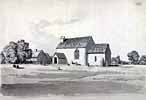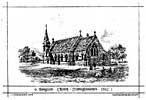For this church:    |
|
 Grimm’s drawing of Grimm’s drawing ofBoughton church in 1773 |
Unfortunately we know little about the church itself. According to Cox, writing in 1912, it was an old parochial chapel which was demolished in the early eighteenth century. This clearly was not the case as it was still in use down to the middle of the nineteenth century, but it was a modest construction described in the 1860s as ‘an humble building, with a turret belfry’. In Samuel Grimm’s drawing of the church dated to 1773, it is depicted as having a nave with a late 13th century window, a south porch, bell turret and a chancel much smaller with lower walls than the nave. It was claimed in 1868, just before it was pulled down, that it had a beautiful Norman chancel arch, so the chancel south window, shown by Grimm, might have been a round headed Norman one. Grimm shows no east window, so we cannot be certain of all the details.
There was also a north door and a three decker pulpit in the middle of the nave. The church stood to the south of the new one, to the east of the path, and the slab of stone with brasses to the Flower family might have been part of the floor. There was an Elizabethan silver chalice made by Nicholas Gorston of Nottingham. A 17th century pewter flagon and two 18th century pewter places were all used in the old church.
The church living was not appropriated and remained a rectory enabling Blyth Priory, as the advowson holder, to choose the priest who would be instituted as rector of Boughton. On 4 February 1403/04 Blyth priory gave up its right to nominate the rector at Boughton. The benefice was united with the vicarage of Kneesall as a chapelry, and the tithes along with responsibility for the chancel, were appropriated by the chapter of Southwell. The vicar of Kneesall was then responsible for both churches.
Southwell took all the income and the vicar of Kneesall had to say divine service three times a week on a Sunday, a Wednesday, and a Friday in the chapel, and administer the sacraments. It is not clear whether or not the vicar was compensated for these extra duties but in 1603 Thomas Pickard, Vicar of Kneesall, had £10 per year paid by the Chapter of Southwell from which he had to pay 43s 4d.
The churchwarden of Kneesall indicated he was required to hire [i.e. rent] a house as no vicarage was available, ‘and further annexed to his cure and charge a chappell called Boughton, distant from him two miles, for the serving of which said chappell he haith no profite anye way.’ The Boughton churchwardens responded: ‘And as we thinks hathe not one penie for his preaching, his paines and laboure though he dwell two miles from us’ From this we may deduce that Southwell Chapter was certainly not very generous to Mr Pickard who had been Vicar of Kneesall and Curate of Boughton since before 1587.
During this latter period and into the 17th century the Chapter had given the income to two prebendaries, Robert Grace and John Cooper, who had acted as rectors and as such were responsible for the repair of the chancel but were negligent in this regard. Year after year the churchwardens had complained that the chancel was ‘out of repair’. This is confirmed in their twice-yearly reports to the Archdeacon of Nottingham in Retford parish church, which commenced in 1587. In 1602 the ‘chancel of the chapel wanteth whiting (white-washing inside) and hath some few glasses broken in the windows’. The windows were still broken in 1613. In 1620 it was actually said that the chancel was down, but that was probably an exaggeration. In 1635 it was still out of repair, particularly the roof, and ‘the window in the east end is daubed up with mortar and stone’. In 1635 there was reported to be ‘no decent communion table’, and in 1638 no altar rail.
The old church was not mentioned by Thoroton, or by Throsby in his updating of Thoroton in the 1790s, but we can deduce that one of the problems with the church was that it was too small for the community. In the 1851 religious census the ‘ancient parish church’ was said to have 12 free and 67 other seats. On census Sunday there was an afternoon service with 80 in the general congregation and 78 others. Since 158 people could not have crowded into the church, the Sunday School must, presumably, have met elsewhere.
By Order in Council dated 10 November 1866, Boughton was separated from Kneesall, according to the register of the Bishop of Lincoln, and made a perpetual curacy. The major advantage of this change was that Boughton became an independent benefice. The first vicar, the Rev George Senior Wilkinson Kershaw, together with Mr W J Pickin and Mr John Thomas Simpson, the churchwardens, started raising money towards a new church. Pickin was agent to the main landowner, Earl Manvers of Thoresby Hall, and was responsible for commissioning the stained glass for the east window, the school (subsequently village hall) and schoolhouse (1861) on Pickin’s Row.
An application for the provision of a new church was made and a letter sent to members of the parish and other interested parties to the effect that the existing building was:
'in a dilapidated and unsafe condition and incapable of substantial report. It is also too small to accommodate more than one-fourth of the population of the Parish. Owing to the want of space many of the Sunday School Children are seated within the Communion rails.'
 Architect’s drawing Architect’s drawingbefore the building of the new church |
A committee was appointed, a subscription list was opened, and James Fowler of Louth was appointed architect. Pickin laid the foundation stone on 19 September 1867, and the church was consecrated by the Bishop of Lincoln on 15 September 1868.
The new church was built in the style of the early 14th century on an extension of the churchyard to the north of the original church building which itself was situated at the corner of the old lane from Kirton/Ollerton and Boughton. The Hon & Rev J L Saville, lord of the manor, and lessee of the great tithes, which were appropriated to the Dean & Chapter of Southwell, gave the land, though Mr Pickin is also credited with giving some part of the extra land. It was built in Steetley Stone with ashlar facings of the characteristic yellow Ancaster stone.
Whilst its simplicity and size may have been an amalgam of the funds available for the structure to be built, some £1600, seating for 200 people was provided with a clearly defined chancel, choir and nave.
The appeal for funds was led by Mr Pickin with an initial donation of £200, equally matched by Mrs and Miss Frogson £200 and Mr and Mrs Simpson also £200, but many of the other parishioners also gave smaller but generous amounts. The collections and donations at the consecration were £85 6s 1d.
Apart from these generous donations, the fine pulpit was the gift of Mrs & Miss Frogson, the church tower clock by Mr & Mrs Simpson, the church plate consisting of a chalice and paten, together with the original organ by Mr Pickin.
Amongst all these good deeds the Harvest Festival of 16 October 1885 must not go without further report. The village, church and supper rooms were all lit with electric lights, the first time this was used in the parish, and an elaborate supper was given by the Rev Thomas Inglis Luard, the perpetual curate of Perlethorpe, an adjacent parish, which is said to have cost some £1000. Spiers and Pond of London were the caterers, bringing all the food up from town, the centrepiece was a 20lb baron of beef on a silver salver. The schoolroom and Mr Greenfield’s barn were used to seat some 500 people for the meal, taken in two sittings.
By order 19th August 1889, the patronage, which had passed from the chapter of Southwell to the Bishop of Ripon, was acquired by the Crown by exchange.
In 1912 the church could seat 200 people, there were 54 on the school roll and 22 on the Sunday School roll and there had been 9 baptisms in the previous year.
The parish magazine dated January 1938 indicates this year would be the last for the annual outing for the choir boys and girls and instead they would receive payment.
Following a faculty reported in the parish magazine dated April 1938 electric light was to be renewed in the church.
The prosperity of the area and parish has varied over the recent past owing to the demise of the local colliery and subsequent closure of the attendant industries. This, it was considered, necessitated a union with the other local parish of Ollerton. This was formalised under the Faculty No 11104, and Order in Council dated 1 June 1987, for the Union of benefices and parishes of Ollerton and Boughton.






